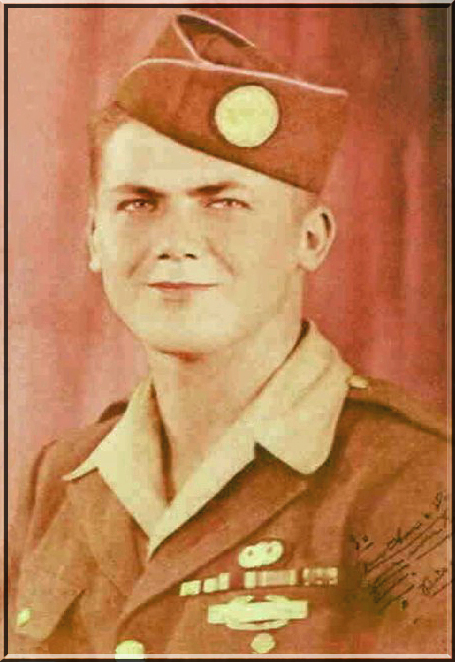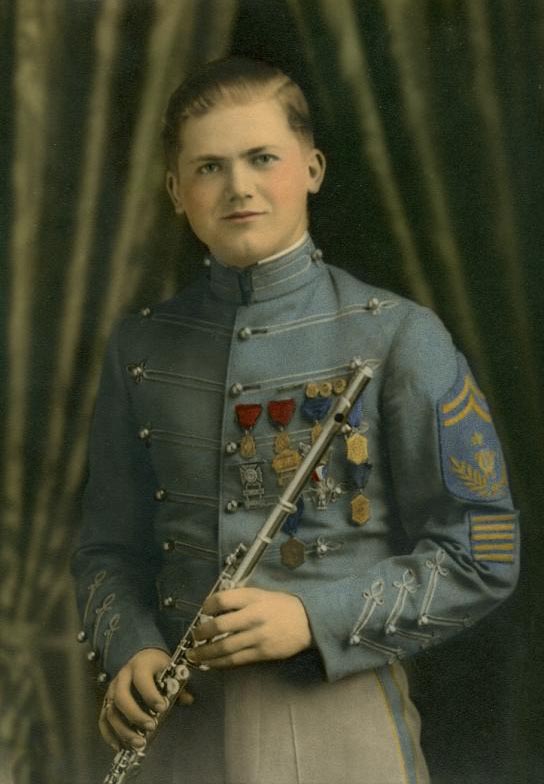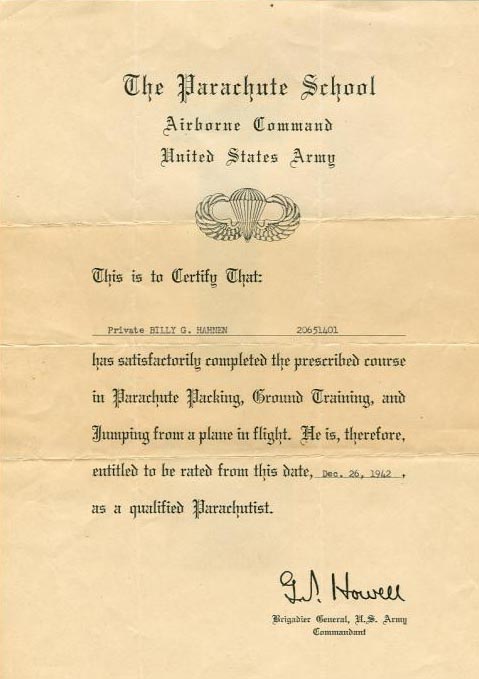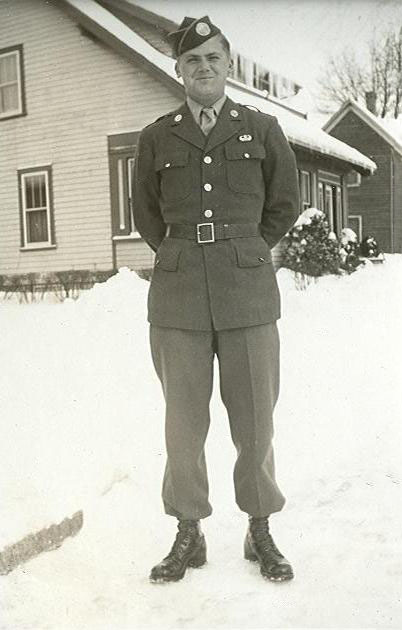
|
|
|
|
|
|
CONTACT US |
|

 |
|
||||||||||||
 |
|||||||||||||
|
Bill Hahnen hailed from Appleton, Wisconsin. He was an Eagle Scout and musician in the Appleton City Band. While a band member, Bill joined the Army Reserve's 120th Field Artillery Band in the early fall of 1940.
A local newspaper "The Post-Crescent" describes their departure in an article dated October 19th 1999.
"Nearly 15,000 people crowded the streets around the Chicago & North Western depot in downtown Appleton on a chilly night, October 22, 1940, to bid farewell to 29 local soldiers who were headed to a Louisiana military training camp armed not with rifles but with trumpets and saxophones and drums. Mayor John Goodland, Jr., and other Appleton dignitaries stood at attention as the members of the 120th Field Artillery Band marched from the Armory down College Avenue and up Appleton Street to the depot. Flares lit the route. The band played. Factory whistles blew. Well-wishers waved flags and sang the “Star Spangled Banner.”
At 8:10 p.m., the 28-car National Guard Special, pulled by “two gleaming locomotives,” rolled into the depot from the north already carrying more than 500 Wisconsin guardsmen. The band and more than 100 other area soldiers climbed aboard.
Thirty-six hours later, they would get off the train at Camp Beauregard, Louisiana for a year of training. It was not yet war time; but, within a week, the first lottery numbers would be picked for the draft."
On November 18, 1941 Bill was discharged from the Army due to his fathers declining health. He moved back to Menasha to help his parents.
|
|
Phil Mattson, also from Appleton, was a friend of Bill’s. They both served together in the 120th Field Artillery Band. Phil had volunteered to become a paratrooper, influencing Bill to also join. No doubt the chance to earn an extra $50.00 a month was an incentive for both men.
It's not clear exactly when Bill volunteered for the paratroopers. However, according to the book "Fierce Individualists" by E companies Dennis O'Loughlin, we do know that a cadre of buck sergeants from the paratroops' at Fort Benning, Georgia visited Camp Roberts near the end of June 1942. Dennis said "They were decked out with their pants inside polished jump boots and wearing their parachute wings." So it may have been on a subsequent visit to Camp Roberts by the paratroops' buck sergeants from Fort Benning, that Bill volunteered. On December 26th 1942, he earned his wings after completing four-weeks of jump school. Bill stayed on at Fort Benning and between December 28th 1942 through January 9th 1943 completed an additional course in parachute demolition training.
Bill reported to Fort Benning, Georgia assigned to G company of the 505th Parachute Infantry Regiment. His training continued until April 20th of 1943 when the Regiment shipped out by train to Fort Edwards, a holding area on Cape Cod, Massachusetts. From here they left for Staten Island, New York and sailed for North Africa.
The Regiment arrived in Cassablanca on May 10th 1943. Training continued in the desert heat until Bill's first combat jump into Sicily the night of July 9th 1943, during this campaign he participated in the battle for Biazzo Ridge. His next combat jump, several months later, was on Paestum, Italy on the 12th of September. After occupation duty in Naples, Italy, the Regiment was shipped to Ireland for replacements and refitting. In preparation for the invasion of Europe the 505 was moved from Ireland to England in February of 1944.
Bill tells of his 3rd combat jump on Normandy, France the night June 5/6th 1944 to his local newspaper the Appleton/Post-Crescent June 4, 1994.
Bill Hahnen was the 13th man in his stick of 82nd airborne paratroopers to leap out of the door of a slow-moving C47 transport and into the night sky near Ste. Mere Eglise, France. It was about 1:15 a.m. on D-Day. “There were so many tracer shells coming at me I thought I’d have to open my legs to let them go through,” Hahnen said.
Far below, the people of Ste. Mere Eglise, an important German communications and transportation center, were battling a fire in the town when paratroopers from the 82nd dropped in their midst. German soldiers in the town killed the paratroopers almost as fast as they landed, including several tangled in trees around the town square.
For Hahnen, a member of the 505th Parachute Regiment, 13 didn’t prove to be an unlucky number as his group of more than 20 paratroopers dropped five miles short of the town in a farm field absent of any German resistance. “My biggest fear was coming down in a tree and being hung there helpless,” Hahnen said. “I was scared and just wanted to get on the ground, get going and hope I didn’t get racked up too bad on landing.”
Hahnen said each paratrooper carried at least 100 pounds of equipment. “Each man had a land mine plus ammunition and a rifle. I had a bazooka. Some of the other guys had machine guns to carry,” he said. On landing, Hahnen immediately joined 20 other paratroopers, “Our objective was Sainte Mere Eglise,” he said. “After we regrouped, we started out.”
On the way to town, the paratroopers made frequent use of a toy “cricket” given to all 82nd Airborne members for use as a means of identification in the darkness. One click of the cricket’s steel underside was to be answered by two clicks. “It was a paratrooper’s walkie-talkie,” Hahnen said. “In the dark, we couldn’t always tell if they were Germans or Americans.” Hahnen and his fellow paratroopers walked with one hand on the cricket and the other cradling a gun, ready to fire in the absence of two answering clicks.
|
|
“We were ready to shoot. If you didn’t shoot, the other guy probably would. That’s the way it worked,” Hahnen said. “Some guys didn’t make it because they were too dumb to be ready to shoot.” Hahnen’s group reached Ste. Mere Eglise about 10:00 a.m. and saw the dead paratroopers hanging in the town square. “We were under the command of Lt. Col. Ed Krause of Neenah. He told us to get our asses over there and cut those troopers down,” Hahnen said. “The sight of those guys hanging there scared us, but it also made us mad. We took it out on the Germans. If we caught one of them, we’d just shoot the SOB. We didn’t mess around with them.”
Set up in a perimeter that night, Hahnen, a 22 year-old Private First Class, shot his rifle for the first time since that morning’s landing. “We were dug in along a hedgerow just outside of town,” he said. “I was standing guard duty and there was a big tree in the field about 100 yards in front of us. I thought I saw something down there. I had a tommy gun at the time, so I opened fire. “The next morning, we found a dead cow in the field.” (Dad always kept his war memories “light”, very seldom sharing the true horrors he saw and faced on a daily basis.) Hahnen said German tanks and infantry tried to regain the town the next day but “never got in.”
Hahnen stayed in France for 33 days before being pulled out with the 82nd to prepare for the airborne invasion of Holland in September. “I’m proud to say we went in there (Normandy) first,” Hahnen said. “We gave everything we had and we took a lot of dead Germans and a lot of German prisoners.”
In the interview above Bill did not talk about the Silver Medal he earned in Normandy, France on June 14th 1944. The citation appears below, just double click on the image for a larger version.
As the Allies continued their attempt to seal off Normandy's Cotentin Peninsula, the 505 was entering into the town of St. Sauveur le Vicomte. * Moving to the southeast of the town with third battalions companies G and I in the lead, the axis of their advance being the St. Sauveur le Vicomtte - Portbail highway, they reached the railroad on the east of town without difficulty, but there they ran into a strong enemy force dug in along the embankment and backed up by tanks.* It was here Bill and his partner (Pfc. Allmon Boland) each earned the Silver Star medal when they volunteered to set up a tank trap with their bazooka as the Germans were counter attacking St. Sauveur le Vicomte. With two direct hits on the lead tank, partially disabling it, they prevented the movement of other tanks. Lieutenant Jack Isaacs, (now commanding G company) then hit the Germans on their flank, which caused them to withdraw. With all officers of G company wounded or killed in action, Lieutenant Isaacs continued the attack with his non-commissioned officers (Corporals and Sergeants). * It was later estimated by the Germans that the taking of St. Sauveur le Vicomte hastened the fall of Cherbourg by two weeks.*
(* Excerpts from the book "Ready" by Allen Langdon *)
On July 13th 1944, the Regiment returned to England after 33 days of front line fighting in Normandy. During this period the 505 absorbed the many replacements needed to replenish their ranks. On September 17th 1944 Bill made his fourth combat jump into Holland, the Regiments first in daylight hours. The 3rd Battalion was responsible for the taking of Groesbeek and to secure drop zone N for gliders and air supply drops. As September was about to turn to October, Company G took up positions southeast of Groesbeek previously held by the 401st GIR.
It was in this area, on October 4th, a G company outpost was overrun during a strong German counterattack. The outpost was manned by Privates Elmer Baker, Jack Busch and Callies LaBlanc. Private Baker was killed in action and privates Busch and LaBlanc were taken prisoner. The outpost was set afire and the building burned throughout the night.
On October 8th, several days after the counterattack on G companies' position, Bill was getting uncomfortable in his foxhole. He turned himself around 180 degrees, placing his head where his feet had been, just as he was settling in, a tree burst exploded over his foxhole shattering his left ankle and sending shrapnel through his right ankle. Bill was flown to a hospital in England, where surgery was performed on his wounds. On December 1st 1944 he arrived in the United States and underwent further treatment. On September 7th 1945 Bill was honorably disharged from McGuire General Hospital in Virginia.
Excerpts from "A Quiet Hero" by Nancy Hahnen McCormick, an unpublished work.
Private First Class Billy G. Hahnen.

Bill Hahnen pictured below in his Menasha High School
band uniform. He was a first-rate flute and piccolo player.

Jump school completion certificate.

Private Bill Hahnen in Wisconsin January 1943.

Private First Class Billy Hahnen's Silver Star medal citation.

News article on Bill's Silver Star award.

Bill's honorable discharge document.
Private First Class Hahnen earns the Silver Star
medal in Normandy, France on June 14th 1944.

Our thanks to Nancy Hahnen McCormick, Bills daughter.

|
|